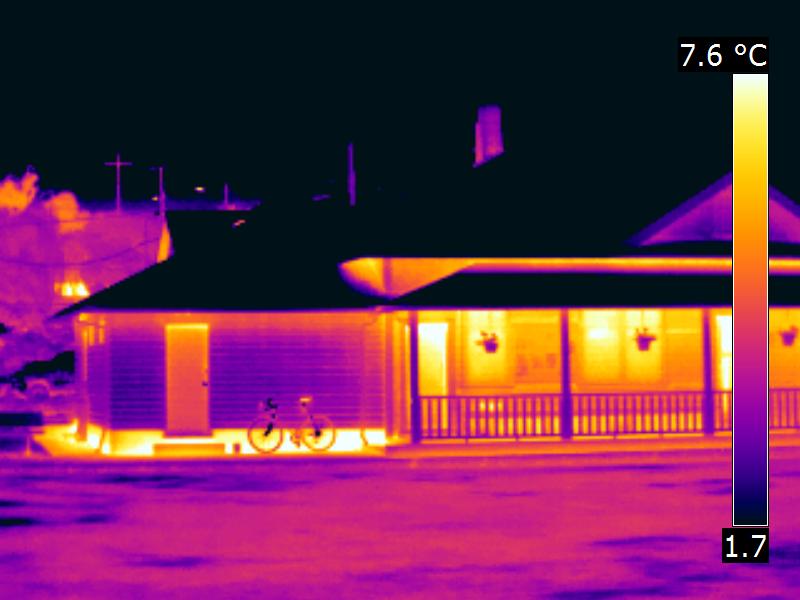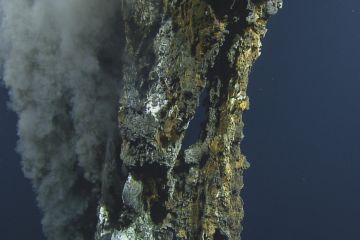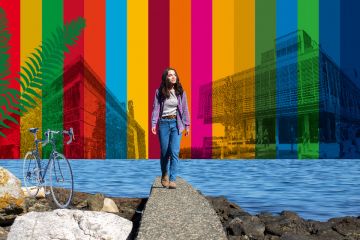Seeing is believing: why thermal imaging can inspire home retrofits

Being able to see where heat is escaping from your own home is a powerful—and underutilized—way to encourage home energy retrofits, especially when those infrared images are packaged with other incentives and promoted within your community.
That’s a key finding that researchers want energy efficiency promoters across Canada to know. Some 63 per cent of energy use in Canadian homes is from space heating, so heat loss is expensive and wasteful.
The report, Motivating communities to retrofit their homes: The potential of thermal imaging in BC, has been produced by researchers at the Collaborative for Advanced Landscape Planning at the University of British Columbia (UBC), and funded by the University of Victoria-led Pacific Institute for Climate Solutions (PICS). The UBC team examined the impact of programs in the United Kingdom and North America that used thermal imaging (TI) to encourage home improvements such as window and draft sealing, and insulation.
TI cameras produce digital images that show relative temperature differences—thus identifying problems such as heat loss from floors, windows, walls and roofs, dangerously hot electrical connections and areas of water leakage and damage. While thermal imaging isn’t a new technology, the report shows that combining visual evidence with incentives and community support can be a winning strategy.
Lead researcher Lisa Westerhoff says one example is the West Vancouver Eagle Island initiative, where 26 of the 31 homeowners retrofitted their houses after receiving a TI energy audit along with information about financial rebates, during community-led meetings. She says the average carbon footprint of the retrofitted homes dropped from 5 tonnes of carbon dioxide per year to 1.7 tonnes of CO2 as a result.
Eagle Island’s community-driven approach has since spread to 11 other neighbourhoods on the North Shore, Bowen Island and beyond, with more than 1,000 homes receiving thermal audits.
“We passed along this research to the City of Vancouver, which has launched its own new neighbourhood level TI program for homeowners, and I would encourage other municipalities across BC and Canada to also do so,” Westerhoff says. “The numbers tell the story. More people will address energy wastage when they see it happening in their own home, especially when their neighbours are also taking action.”
The report notes that using drones can provide TI footage of less accessible areas such as roofs, as well as comparisons across communities or even cities—as is shown in this YouTube video clip from the UK.
Residential housing produces around 19 per cent of Canada’s total greenhouse gas emissions—making it a priority area for reducing our carbon footprint. The report offers 30 specific recommendations for how government, utilities, researchers and neighbourhood groups can better utilize TI technology as part of housing retrofit outreach programs. It is available on the PICS website under “Research white papers.”
That’s a key finding that researchers want energy efficiency promoters across Canada to know. Some 63 per cent of energy use in Canadian homes is from space heating, so heat loss is expensive and wasteful.
The report, Motivating communities to retrofit their homes: The potential of thermal imaging in BC, has been produced by researchers at the Collaborative for Advanced Landscape Planning at the University of British Columbia (UBC), and funded by the University of Victoria-led Pacific Institute for Climate Solutions (PICS). The UBC team examined the impact of programs in the United Kingdom and North America that used thermal imaging (TI) to encourage home improvements such as window and draft sealing, and insulation.
TI cameras produce digital images that show relative temperature differences—thus identifying problems such as heat loss from floors, windows, walls and roofs, dangerously hot electrical connections and areas of water leakage and damage. While thermal imaging isn’t a new technology, the report shows that combining visual evidence with incentives and community support can be a winning strategy.
Lead researcher Lisa Westerhoff says one example is the West Vancouver Eagle Island initiative, where 26 of the 31 homeowners retrofitted their houses after receiving a TI energy audit along with information about financial rebates, during community-led meetings. She says the average carbon footprint of the retrofitted homes dropped from 5 tonnes of carbon dioxide per year to 1.7 tonnes of CO2 as a result.
Eagle Island’s community-driven approach has since spread to 11 other neighbourhoods on the North Shore, Bowen Island and beyond, with more than 1,000 homes receiving thermal audits.
“We passed along this research to the City of Vancouver, which has launched its own new neighbourhood level TI program for homeowners, and I would encourage other municipalities across BC and Canada to also do so,” Westerhoff says. “The numbers tell the story. More people will address energy wastage when they see it happening in their own home, especially when their neighbours are also taking action.”
The report notes that using drones can provide TI footage of less accessible areas such as roofs, as well as comparisons across communities or even cities—as is shown in this YouTube video clip from the UK.
Residential housing produces around 19 per cent of Canada’s total greenhouse gas emissions—making it a priority area for reducing our carbon footprint. The report offers 30 specific recommendations for how government, utilities, researchers and neighbourhood groups can better utilize TI technology as part of housing retrofit outreach programs. It is available on the PICS website under “Research white papers.”
-- 30 --
Photos
Media contacts
Robyn Meyer (Senior communications officer, Pacific Institute for Climate Solutions) at 250-588-4053 or rmeyer@uvic.ca
In this story
Keywords: sustainability, research, clean energy, PICS
People: Lisa Westerhoff






